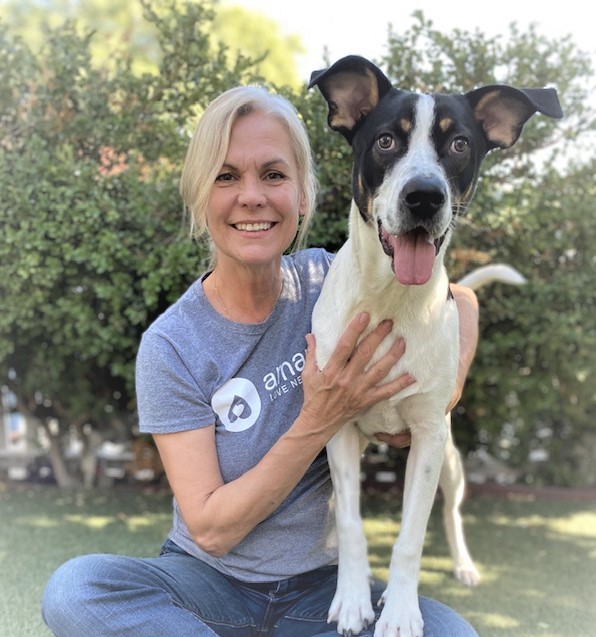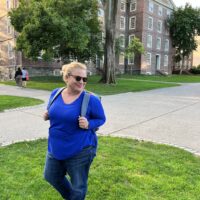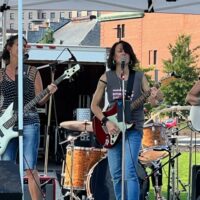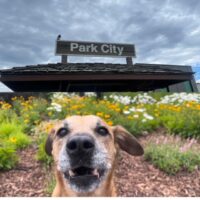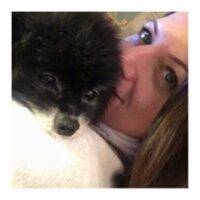In Man of the House: Life with the Lady at the End of My Leash, yellow Labrador Mac calls Mary and all humans “leashers.” Today I talk with Teri Austin, President of Amanda Foundation, who rescued and healed my beloved dog, Arden. But Amanda Foundation is so much more than a rescue. Their “four legs” include a veterinary hospital, a spay-mobile clinic, rescue and adoption, and educational programs. Teri has been involved with Amanda for more than thirty-five years. She left what most of us would consider a dream job to live out her childhood dream to be surrounded by animals.
1. Tell me how you got involved in Amanda Foundation.
I came to Los Angeles to work on the television show Knots Landing. I moved here from Canada and brought my almost nineteen-year-old Yorkshire Terrier named Theda Bara, after the first movie star who ever existed. I called her Thea, and she was an amazing little dog that I loved with my whole heart.
There was a veterinarian close to the studio where I took Thea. He had a little index card taped to the wall that said, “Please give to the dogs of the Amanda Foundation.” I was making more money than I’d ever made in my life, and I thought, “Sure, I can donate to them.” So every time I took my little dog, I would hand them a check and say please give it to the charity. Because she was so old, she was at the vet on a fairly frequent basis.
So my little Thea passed. She was elderly and had a condition and finally succumbed. A few weeks after she passed, my veterinarian called, “So Teri, did you get yourself a new puppy?”
“Oh Steve, I’ll never have another dog as long as I live. I can’t sleep. I can’t eat. I cry constantly. I am so broken hearted. I will never, ever have a dog. It’s just too much.”
And he says, “Okay, so you know that charity you give the checks to? Think you could do something in memory of Thea? You should go over there.”
I thought to myself, “Ok, fine. I’m going to drive over there. Give a check in memory of my dog. Get back in my car, and drive into the sunset. That’s what I’m going to do.” I go to the Amanda Foundation, get out of the car, walk in and say, “I have a donation in memory of my dog that passed. Who should I give it to?”
The Foundation had one employee at the time. It had only been in existence for a year. She looked at the check and said, “Let me show you what we’re going to do with this.”
And I was thinking, “No, please don’t.”
“Come on back.”
So we went back to the kennel and there were forty cages filled with dogs, some two in a kennel. I just started balling. She walked me up and down the aisles. I’m crying so hard that my blouse is wet with tears. I’m crying for my dog. I’m crying for these dogs. When we get to the very last cage, there is a Yorkie mix. Now when I say a Yorkie mix; frankly, I am more Yorkie than that dog was. She was clearly an elderly dog. She had like little orphan Annie wide eyes with cataracts. She had big Yorkie ears. Her little teeth were green. She was limping on one leg, and I thought to myself, “Oh Lord, this is not a long-term commitment. I am going to take this dog. She has maybe another six weeks on the Earth. I’m going to take her and just give her a home for what time she has left.”
“I’ll take her.”
I swear that dog got younger every week. I got her teeth cleaned, gave her vitamins and a better diet. I had her for nine years. The doctor thinks she was nineteen when she passed.
2. So how did you get further involved?
So I saw what they did, and I started going back to volunteer. I was working twelve-to-fourteen-hour days on Knots Landing. On days that I finished early, I would come by the Amanda Foundation with my great big eighty’s hair and my eighty’s makeup, shoulder pads and high heeled shoes. I would bring jeans and a sweatshirt to change into, and then I’d shovel poop. Here I was working on a top ten television show and being on the cover of magazines, and then I was shoveling poop.
Being with the dogs was so much fun for me, and I just loved watching them go home. I realized that I could help the charity by drawing attention to it. And so I started working on events and slowly transitioned over the years to wanting to do this with my life.
I’d been working in the industry since I was fifteen, and I had a very nice time in showbiz. I was so fortunate. I’m sixty-four now, but by the time I was in my mid-to-late forties, I decided that I was done. It wasn’t for lack of work, but I was doing the same roles. You get type-cast. I’d play the senator’s wife and the lawyer and the whatever, just the same role so many times.
Now looking back on it, I was an idiot because I had a good income. I should have balanced it more. But at the time, I was ready to go. I said to my manager, “I can’t even make it through a whole script. I’m just not interested. I am not excited about the work.”
She said, “Teri, you’ve been doing this since you were a kid. Take time off. When you’re ready to come back, we will be here. Take a year off.”
But I never went back. Once I left the industry, I realized that everything the universe had taught me about how to be an actress, I could apply to saving animals. I could go down to City Hall and advocate. I could get that audience of fifteen council people and the mayor, and I could hold them in my hand and talk to them about what needs to be done, and I could sell it to them just like I would sell a character in a play.
I started to accomplish things, and I thought, “This is what I need to do.” The acting was great, and it gave me a chance to travel the world. And everywhere I went when I working as an actress, New Zealand, Geneva, the Caribbean, I would take my free time and go to a local animal charity. I’ve seen animal charities all over the world and I was able to bring back ideas.
When I was in Geneva in the early nineties, I went to the SPCA. It was in this nice little building. I walked in and said, “Hi. I’m working in Geneva for a few months. This is my day off and I really like to help with whatever I could do.”
And the woman said, “Oh, well, what would you like to do?”
“I can walk some dogs.”
“OK, yes, we have two.”
In a city of one-and-a-half million people, they had two dogs in the city’s one animal shelter. And one dog was boarding while the people were away. The other’s owner had died, and they were looking for a home. I had to know how they did this. Switzerland’s is famous having rules for everything, and they had strict spay and neuter rules and strict breeding rules. That was my inspiration to come back to L.A. and say, it’s not a matter of rescuing. It’s keeping them from being in the shelter in the first place. That’s where you start. That’s how you solve the problem. You solve the problem by not overproducing more animals than there are homes.
3. When did you start full time at Amanda?
Late 90’s. I guess it was ’98 or ’99.
4. What is your favorite part of the job?
I have two. My favorite thing is seeing animals in distress and being able to rescue them and take them out of the distress. It’s like a sunburst goes off in my chest. Once I have them in my car and can say, “You’re safe.” The other is when they go home, and you see a family that’s so excited to have this creature, this dog or cat, that someone else threw away.
5. What is the hardest part of your job?
The hardest part is when I can’t take anymore because we’re full. Or in some situations, the animal has been abused badly and is dangerous. I might already have three like that, and I can’t take a fourth because we’re already dealing with the other three. That’s the hardest part, saying no and knowing that we’re probably their last chance. I cry every time. We only have so many cages and so much money, so I have to say no. And that devastates me. That’s the hardest thing. That is harder than having to say goodbye to your pet and let it go to heaven for a health reason, even one you dearly love.
6. How has COVID affected your business?
Initially when we had to shut down our spay and neuter program, I thought we were going to see this big wave of puppies and kittens, but that didn’t happen. It proved something we’ve been preaching all along. If you are at home and you keep your gates locked, your pet is not escaping and coming back pregnant or impregnating other animals. It’s not getting hit by a car and you can’t afford to fix it and it dies at the shelter. You are exercising your pet more, so they’re better behaved. Cats are predators, so they do have a different DNA. But dogs are pack animals. You can’t isolate them for twelve hours a day, come home and spend ten or fifteen minutes with them and think you’re done. So COVID taught everybody that this is how you fix it. You spend time with them. The reasons that animals were in the shelter were solved by people being home more.
7. Let’s talk about the building plans for the Amanda Foundation.
Well, I joke that the only thing older on the property than me is the building. The building was built in 1924 where the veterinarian, Dr. Scott, treated livestock. The Farmer’s Market (located now by CBS and a Nordstrom’s) was a true market where farmers bought and sold pigs, chickens, geese, goats, and cows. In the thirties, as horses were being phased out and more people had cars, L.A. was getting built out and the farms were moving out. Veterinarians were switching to small family animals because before then, at the turn of the century and in the early twenties, if you had a dog and it got sick, you got a new dog. But then as people started to care for their animals more, the building became a small animal hospital.
The building was never built to last a hundred years. It’s an old stucco building that is termite ridden and there’s holes in the roof. It has heating and cooling in only a third of the building. The ventilation is poor. The plumbing is ninety-six years old and there’s something breaking all the time. It was not made to house animals long-term because most veterinarians are only housing animals for the day for a procedure or for a few days to get over an illness. But we take animals that are ill and injured that need weeks, if not months, before they are ready for adoption. We have made do with what we have, but the building is literally falling down around us.
8. What will the new facility be like?
We are working with Animal Arts, an architectural firm out of Colorado, which deals specifically with animal hospitals and shelters. They have designed a beautiful and functional building, where every square inch will be used for housing the animals and for our programs.
The facility will be a pleasant place for an animal to spend a long period of time with indoor and outdoor exercise areas. The pets in our care will have such a better quality of life. We’ll be able to offer more services. I want to create an ambience that when people come in, it looks and smell nice. I think we’ll get more foot traffic and adoptions will go up. Our hospital will have more room. We take on animals that need lots of medical attention. Much of our work is pro bono, but what we do charge for helps fund the charity.
We’re going to have a seminar room to teach classes like, “Why do animals need to be rescued? What are the top ten reasons they end up in the shelter?”
“Oh, my kids allergic. My aunt died and left me all these cats. Or my aunt’s old and we can’t take care of her cats anymore. I can’t train this dog. It keeps jumping up and knocking me over. I can’t potty train.”
I want to have seminars to teach people how you help your aunt keep pets into her old age; how you introduce the baby to the new pet, how you introduce a new pet to another new pet; how you train your dog so it doesn’t chew up your whole house while you’re at work. By creating preventative classes so animals don’t end up in the shelter and by having the spay mobile offering medical services there are less animals being produced. Our goal is to attack all the reasons why animals end up in shelters, so we end up with less animals in the shelter.
One of the best things about the new building is all these decks where we’ll be able to train dogs. We’ll have three or four different areas where we can take animals for separate training depending on how socialized they are. Those same deck areas can be used for events. We’ll never rent a venue again. We’ll have this beautiful building where every event will include touring the hospital and seeing the animals, and you’ll see where your money’s going.
9. When do you think you’ll break ground?
Everything has been held up by Covid. The City of Beverly Hills, all but shut down. We are waiting on the results of a seismic study to finalize our plans. After that, we’ll submit our plans to the city. It usually takes eight months to a year to get the necessary permits. So maybe by October or November 2022, we can put a shovel in the ground if we have the money by then. If not, we have a year-and–half before we would have to reapply for permits.
10. How long do you think it will take to build?
It should take fourteen months. I will not be surprised if it takes a year-and-a-half. I don’t think it’ll take two years. I think it’ll be eighteen to twenty months.
11. How can people help? How can they donate?
People can donate to our general fund or earmark it for our building fund. We appreciate every level of giving at Amanda Foundation. If somebody wants to donate $3.50 to pay for a rabies vaccine, I’m very grateful for that because we do a lot of rabies vaccines.
We will soon be launching our hard campaign, and we are working on a deck that includes opportunities for giving. Maybe it’s a brick in the patio that is hundred dollars or a kennel with a nameplate in memory of your beloved pet. The new kennels are prefab so there’s no seams to catch virus and they’re perfect, but they’re five grand a piece. But then you’re hoping that you can also get someone who wants to give you $200,000 to pay for the plumbing that goes under the forty kennels. Every level of giving is incredibly necessary and there will be opportunities for everyone.
During this almost two-hour interview, I was so impressed with Teri’s business acumen. She told me that she got her business sense from being an actress. “It’s show business, not show art.” In gratitude for saving my Arden and in awe of the impact that Amanda Foundation can make with the new facility, fifty percent of the royalties from Man of the House: Life with the Lady at the End of My Leash will be donated to their building fund.
